Search This Blog
A strolling guide to New York City and beyond by writer and photographer Teri Tynes. The site was most active in the years 2007-2021 and is no longer updated.
Posts
Showing posts from February, 2020
A Weekend Walk on the Old Croton Aqueduct Trail
- Get link
- Other Apps
A Walk in the Heights: From Fort Tryon Park to Fort Washington Park
- Get link
- Other Apps
Central Park in Winter: A Walk to Belvedere Castle
- Get link
- Other Apps




